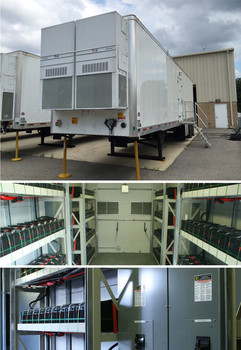Losing power can mean disaster for critical operations like hospitals, government facilities, financial institutions and data centers. At risk are patients’ lives, national safety, public services, economic security and vital digital information.
Sure Power, with operations in Philadelphia and Baltimore, has been providing uninterruptible power supply (UPS) systems to mission-critical operations for 22 years. The technicians at Sure Power’s UPS Rental are on call for immediate deployment in the event of a power outage, surge or interruption of any kind. They can deliver trailer-mounted UPS systems anywhere in the U.S. within two hours of receiving a call. Gene McNeil, Vice President of Critical Power Systems at UPS Rental, and his crew use Sensaphone remote monitoring systems to alert them of problems with the UPS systems.
The main function of a UPS system is to provide short-term power when the input power source fails. “In the event that power goes out, flickers or surges, the battery-powered UPS system stabilizes the utility power and backs it up,” said McNeil.
Recently, a major public utility company experienced a failure of its critical charger, threatening much of the state’s power grid. Running on back-up batteries, the company contacted UPS Rental. A field engineer delivered and commissioned a rental system before the company’s back-up batteries were depleted, resolving the crisis in less than four hours.
Monitoring Keeps the UPS Uninterruptible
UPS systems are superior to generators because they don’t cause power interruptions when they start up. In the event of a power outage, the UPS system’s batteries kick in to keep the customer’s operation up and running. UPS systems are always online.
“Our UPS systems are so critical that they have to be monitored. We have engineers on-call 24/7, 365 days a year who are responsible for making sure our UPS systems are operational. They cannot fail,” McNeil explained. “Sensaphone devices are constantly monitoring the UPS systems, the alarms they generate and the surrounding environment. If the Sensaphone device detects a problem, it notifies the on-call technician that something is wrong.”
UPS Rental’s trailers are self-contained outdoor units that house UPS systems ranging from 15,000 watts to 2 megawatts. McNeil and his technicians use 28 Sensaphone CELL682 devices to monitor the trailers’ UPS systems and air conditioners.
Planned Power Outages Require UPS Backup Too
UPS Rental’s systems are also used for planned power outages in situations like construction, renovation, relocation and system upgrades.
“In these cases, customers rely on us to provide a temporary UPS system to ensure there is no operational downtime. When a customer can’t have even a split second of outage time, they rely on our systems,” said McNeil.
Cellular Capability for Nimble Monitoring
UPS Rental uses Sensaphone cellular monitoring systems because the UPS system trailers don’t have a network or internet connection. Running cable and phone lines between the trailer and the customer’s facility is cumbersome, slower to set up and not always logistically possible. Moreover, the technicians usually aren’t permitted to connect to the customers’ network for security reasons.
The CELL682 systems use standard cellular networks, monitor up to 14 critical conditions and send alarm notifications to up to 24 voice, text or email destinations.
“Just two weeks ago, we had an alarm and were able to get someone from Philadelphia to the customer’s site in Chicago that night. And it was all thanks to the CELL682 notifying us that there was a problem,” McNeil explained.
Proactive Monitoring
UPS Rental is preparing to upgrade its monitoring by migrating to cloud-based Sensaphone Sentinel PRO systems. The Sentinel PRO system supports the Modbus communications protocol and includes a second relay output to monitor and control complex networks. One Sentinel PRO device monitors up to 64 Modbus registers or 12 different digital or analog status conditions.
“The Sentinel PRO will give us more information, which will allow us to be more proactive. The Modbus capability will let us look at things like voltage, current temperature and output current. Based on the readings, we’ll be able to identify a potential issue before it becomes a problem and send a technician to check it out proactively, rather than just responding to alarms,” said McNeil.

